 Diet composition of pregnant mothers in food frequency ...
Diet composition of pregnant mothers in food frequency ...Warning: NCBI web site requires JavaScript to function.
1Department of Agricultural, Food and Nutritional Sciences, 4-002 Li Ka Shing Center for Health Research Innovation, University of Alberta, Edmonton, AB T6G 2E1, Canada; E-mail: (S.M.R.); (L.J.M.); (C.B.)
1Department of Agriculture, Nutrition and Food Science, 4-002 Li Ka Shing Center for Health Research Innovation, University of Alberta, Edmonton, AB T6G 2E1, Canada; E-mail: (S.M.R.); (L.J.M.); (C.B.)
1Department of Agriculture, Nutrition and Food Science, 4-002 Li Ka Shing Center for Health Research Innovation, University of Alberta, Edmonton, AB T6G 2E1, Canada; E-mail: (S.M.R.); (L.J.M.); (C.B.)
2Faculty Physical Education and Recreation, University Hall 3-100, Van Vliet Complex, University of Alberta, Edmonton, AB T6G 2H9, Canada; E-Mail:
1Department of Agricultural, Food and Nutritional Sciences, 4-002 Li Ka Shing Center for Health Research Innovation, University of Alberta, Edmonton, AB T6G 2E1, Canada; E-mail: (S.M.R.); (L.J.M.); (. C.B)
Objective: Pre-pregnancy is the time under review and potentially important to optimize food intake to support fetal growth and development and maternal health. The purpose of this study was to determine the extent to which food intake was reported by the same non-pregnant women with pre-pregnancy dietary intake by pregnant women reported using the same assessment tool. Methods: The self-administered, semi-quantitative food frequency questionnaire (FFQ) was adapted from the Canadian version of Diet History Questionnaire, originally developed by the National Cancer Institute in the United States. Pregnant women (n = 98) completed the FFQ assessed food intake for the year before pregnancy. nonpregnant women (n = 103) completed the same FFQ assessed food intake for the previous year. Energy, macronutrients and micronutrients key: long-chain omega-3 fatty acids, folate, vitamin B6, vitamin B12, calcium, vitamin D and iron checked. Results: Food intake between the groups; reported by the FFQ; are alike except for saturated fat; trans fats; calcium; and alcohol. pregnant women reported significantly higher intakes of saturated fat; trans fats; and calcium and low alcohol intake in the year before pregnancy compared with non-pregnant women who reported intake in the previous year. Conclusion: Despite the limitations; an FFQ could be used to help the retrospective assessment of pre-pregnancy diet.
It is well known that dietary intake during pregnancy impacts the growth and development of the fetus and the mother's health. However, the status of women's weight and food intake during life and especially before pregnancy can affect fetal growth and development and long-term health of the mother [,]. maternal obesity before pregnancy has been associated with negative maternal outcomes, including an increased risk of miscarriage, gestational diabetes, pregnancy-induced hypertension, venous thrombo-embolism, induction of labor, cesarean delivery, excessive pregnancy weight, and post-partum weight retention [,,,] , Mother's pre-pregnancy obesity is also associated with an increased risk of poor infant outcomes including fetal macrosomia, obesity and increased risk of diabetes later in life [,,]. Because of its importance to maternal and infant outcomes, women's weight status before pregnancy has been emphasized as a key variable in the United States Institute of Medicine gestational weight gain guidelines were published in 2009 [].
While the effects of pre-pregnancy intake of foods that are not well marked, improvements before pregnancy may lower the risk of maternal and fetal outcomes were poor. Maternal nutritional status before conception and during the peri-implantation phase is believed to affect the growth of the embryo and fetus []. Recent research from the Study of Nurses' Health Study showed that increased intake of fried foods before pregnancy was associated with an increased risk of gestational diabetes even after adjusting for several factors including age, body mass index (BMI), family history of diabetes, intake of total energy and quality of the diet [] , Results from studies in animal models are consistent with these results in humans. For example, the model animals fed a high-fat diet before pregnancy showed no adverse effects in the offspring included increased insulin like growth factor 2 receptor mRNA, smaller offspring who experience catch-up growth, and in males, increased cholesterol, increased body fat percent, and glucose intolerance later in life []. Another animal model that utilized a high-fat diet before pregnancy was found descendants have increased storage of fat droplets in hepatocytes and an increase in body weight compared with controls fed standard chow during pre-pregnancy and pregnancy and lactation []. liver tissue in the offspring also have a unique up-regulation of Acacb and Scd1 gene expression in mice fed a high-fat diet during pre-pregnancy period only [].
In addition to the food intake of high-fat, malnourished mother before pregnancy has also been associated with fetal developmental defects. The most common nutrients known defects associated with pre-pregnancy is an increased risk of neural tube defects (NTDs) with low levels of folate mother []. Other nutritional insufficiencies or deficiencies may also be important. One study found that after adjusting for energy intake, low intake of vegetable protein mother, fiber, beta-carotene, vitamin C, vitamin D, iron and magnesium are associated with an increased risk of orofacial clefts in newborns [].
Determine the appropriate method of assessment of food intake during the pre-pregnancy period is important to support interventions in the future. For example, it has been found that women who receive pre-conception advice from a health professional is more likely than other women to make positive behavior changes before pregnancy includes taking extra folic acid and consume healthy foods []. A pre-pregnancy dietary intake assessment tool that has the potential to track changes can assist in determining the impact of the intervention in creating positive change in diet during this critical period. However, recruitment of women before pregnancy is difficult, so a tool retrospectively examined food intake will be important
This study was completed as a pilot project to support the ongoing cohort study. Alberta Pregnancy Outcomes and Nutrition (apron) []. Apron studies are exploring the relationship maternal dietary intake and nutritional status during pregnancy and maternal mental health, birth outcomes and neurodevelopment of children up to three years. Women enrolled in the study apron after they became pregnant, however, as described above, it is important to assess the dietary intake before pregnancy. The purpose of this study was to determine the extent to which food intake was reported by the same non-pregnant women with pre-pregnancy dietary intake by pregnant women reported using the same assessment tool.
pregnant and non-pregnant women were recruited from Edmonton, Alberta, Canada. For groups of pregnant women who are pregnant are eligible to participate in this study. No restrictions are placed on the number of weeks of pregnancy. For groups who are not pregnant, women who have been pregnant for 12 months and aged 17-45 years old are eligible to participate. We do not have information on whether any of the participants are planning a pregnancy. Women in both groups were excluded if they are not able to speak, read, or write in English
A sample size of 100 participants in each group was chosen to allow for comparisons between groups .; The sample size has been identified as appropriate for the validity of votes FFQs []. Although the study did not directly assess the validity of the FFQ, other aspects of the study beyond the scope of this short report did not examine the validity of the relative.
different recruitment strategies that are used for pregnant and non-pregnant group. Recruitment pregnant participants also completed a trial basis for one of the studies Apron recruitment strategies. It was held in conjunction with the Women's and Children's Health Research Institute (WCHRI) at the University of Alberta along with two other studies also recruited pregnant women. After having confirmed the pregnancy in a medical clinic, prospective participants were asked if they would be interested in participating in the study pregnancy. If the individual is interested, his name and phone number WCHRI forwarded to the office. Name randomly among the three studies. After the names and phone numbers received from WCHRI, applicants are called to invite women to participate in the stUdy. It was made clear to the participants that they will take part in a pilot study to test the questionnaire for a larger study. Pregnant women in the study participants Apron.
Non-pregnant participants were recruited through various other methods because there is no affiliation with a medical clinic to recruit women. This method includes the recruitment tables, posters, advertisements in newsletters and word-of-mouth in a variety of locations including the University of Alberta community and the City of Edmonton recreational facilities.
The study was approved by ethics Health Research Council at the University of Alberta, Human Research Study No. Pro00003163 ethics. All participants provided informed consent before participating.
All of the participants reported age, height, marital status, parity, ethnicity, chronic disease, education level, employment status, and annual household income. Pregnant participants reported their weight immediately before pregnancy, and the number of weeks of pregnancy. Participants who are not pregnant reported their current weight. Body mass index (BMI) is calculated by dividing weight (in kilograms) by height (in meters) squared.
FFQ adapted from the Canadian version Diet History Questionnaire (DHQ) [] which was originally developed by the National Cancer Institute in the United States []. The original DHQ utilized the United States Department of Agriculture (USDA) Nutrient Database for Standard Reference (SR11) []. Csizmadi et al. [] Adapting FFQ for use in Canada to reflect differences in nutrition Canadian fortification practices and food availability. Changes made harnessed Canadian Nutrient File 2007b [] Database nutrients for analysis. The FFQ further adapted for the study of attention apron to address nutrition before pregnancy [] and incorporating culturally appropriate food. Changes include the addition of foods fortified with omega-3 fatty acids (eggs, juice, margarine, milk, soy milk, and yogurt), fish portions expanded, and more products multigrain / hemp seeds. In addition, some questions were re-ordered or combined. The nutritional profile of the food additives that are added using the Canadian Nutrient File 2007b [].
FFQ is, semi-quantitative, retrospective questionnaire which asked about food intake during the 12 months prior to pregnancy for the pregnant woman or the last 12 months for women who are not pregnant. Since women were recruited through the time frame of 18 months, and "the past 12 months" is used as a time in which the diet is reported, the differences that occur in food intake according to the season which minimized [].
Pregnant and nonpregnant women completed the FFQ same kind. All data reported are for food and beverages alone, supplements are not included.
nutrient intake in pregnant women compared with nutrient intake in women who are not pregnant. Key nutrients selected for comparison of long chain omega-3 fatty acids, folate, vitamin B6, vitamin B12, calcium, vitamin D and iron. In addition, total energy intake and macronutrient (carbohydrate, protein, and fat) were compared between the groups.
Responses all FFQs is a double-entry into the key-punch program makes use of Microsoft Excel (Excel version 2007) to ensure accuracy.
The assessment of the data outlier FFQ was completed based on realistic reported energy intake of <600 kcal or> 3500 kcal per day, as recommended by Csizmadi et al. []. independent samples t-test was used to compare differences between groups for demographic variables continuously while the analysis chi square and Fisher exact test was used to test the categorical demographic differences between the groups. independent samples t-test was used to compare the average intake among groups of key nutrients measured by the FFQ.
The analysis was performed using SPSS (version 18.0, SPSS Inc., Chicago, IL, USA) except for demographic variables: parity, educational level, household income and where the BMI classification STATA (version 10, StataCorp LP, College Station, TX, USA) was used.
Overall, 98 pregnant women and 103 pregnant women who did not complete the study. Nine participants (seven pregnant and non-pregnant two) were excluded from all analyzes on the basis of unrealistic energy intake reported on the FFQ []. Participants described the demographic information. Compared with women who did not become pregnant, pregnant women in our groupre more likely to have a higher pre-pregnancy BMI (p = 0.003), married (p <0.001), had more children (p = 0.005), use (p = 0.025), and have a household income of more higher (p <0.001). No significant differences were found between the age group, ethnicity, chronic illness, or level of education
Participants Demographic Characteristics
* significant at a p-value of p <0.05 ..; ** p-value is significant at the p <0.01 level; A t-test for independent samples; b Chi square analysis (marital status, ethnicity, chronic illness, job status) or Fisher's Exact Test (parity, education, income, BMI) as appropriate; c Includes students, housewives, unemployed or otherwise. Abbreviation:. BMI (body mass index), kg (kilogram), m (meter), SD (standard deviation)
Energy, macronutrient and micronutrient intake is shown in the main. The pregnant women reported an average intake was significantly higher than saturated fat (SFA) (p <0.05), trans fat (p <0.01), and calcium (p <0.05) compared with the group that did not pregnant. The women who were not pregnant reported average intake was significantly higher than alcohol (p <0.05). Energy intake and all the other macronutrients and micronutrients main was similar between the groups.
Comparison between the Group of Energy and Nutrient Intake Measured by FFQ.
* independent samples t-test was significant at p <0.05; ** independent samples t-test was significant at the p <0.01 level. Energy and macronutrient intake for years before becoming pregnant; b Energy and macronutrient intake during the past year. Abbreviations: FFQ (food frequency questionnaire), kcal (kilocalories), g (gram), mg (milligrams), ug (micrograms), SD (standard deviation), MUFA (monounsaturated fat), PUFA (polyunsaturated fats) , ALA (alpha -linolenic acid), EPA / DHA (eicosapentaenoic acid / Docosahexaenoic).
comparison Novel among the groups used in this study to approach the question of whether or not the food intake was measured by FFQ was similar among pregnant women reported intake in the year before pregnancy and women who are not pregnant reported intake during the year last. It turns out that there are some differences between the groups in food intake, however, is not known whether this difference is due to actual differences in food intake between the groups or differences in recall bias between groups. This is not the traditional assessment of the relative validity of food intake tool wherein the tool compared to the gold standard or secondary method. Assessment relative validity in this population is difficult. Many studies have examined the relationship between FFQs and alternative methods of dietary assessment utilizing a variety of populations, the sample size, FFQs, the reference time period, and dietary assessment methods reference []. In general, FFQs generally believed nutrient intake is too high despite possible that some intake is too high over the other or even underestimate the intake of [,,].
Overall, the same FFQ provides an estimate of energy, macronutrients and micronutrients key: folate, vitamin B6, vitamin B12, vitamin D and iron between groups. However, saturated fat, trans fat, and calcium intake is reported to be significantly higher, and alcohol intake were reported significantly lowered in the pregnant group given the year before pregnancy compared with non-pregnant group considering last year. The reason for this difference could be multi-fold but can not really be seen in this study. There is a possibility that: (1) if planning a pregnancy, some women may have made dietary changes in the year before pregnancy. For example, a woman planning a pregnancy can reduce or eliminate your intake of alcoholic beverages and increase the consumption of other beverages, such as milk. Mean calcium intake difference between the groups was 158 mg which is roughly the amount of calcium in a half cup of milk []. Saturated and trans fats may also be present in milk although in varying amounts depending on the type of milk. So even if some pregnant women to change their beverage consumption as a result of pregnancy planning, nutrition may have been higher. (2) There may have increased recall bias among pregnant women so that they are considered a "healthy" diet in the year before pregnancy. Several studies support the idea that women intending pregnancy make positive behavioral changes including a higher level of physical activity and lower Smoking rate compared to non-pregnant women [], a lower alcohol intake [] and take a multivitamin [] and / or folic acid supplements [,,]. In contrast, pre-conceptions other research shows that women who are planning a pregnancy does not differ much from other pregnant women who did not in relation to health behaviors such as alcohol use [,,], smoking [,], the consumption of fruit and vegetables [,] and physical activity []. There may be differences between the groups in the usual intake regardless of whether the pregnancy was planned or not. In this study, data on whether the pregnancy was planned were not collected as a definitive statement on this issue can not be made.
Pre-pregnancy dietary intake in this study is somewhat similar to the pre-pregnancy intake reported by pregnant women in Portugal [] and the Netherlands [,]. Women in this study were observed to have a lower energy intake [,], lowering fat intake [], higher vitamin D and vitamin B12 lower []. However, this study used a different FFQs, examined women planning a pregnancy or not [], and given to the points at different times, such as during the first trimester [] or postpartum [], which makes direct comparison difficult.
The main limitation of this study is that both FFQs and other dietary assessment tool is considered as the gold standard. A FFQ chosen because it was the only tool that can assess retrospectively the nutritional intake before pregnancy. Reality recruitment procedure for the study of the apron as well as the fact that many pregnancies are unplanned [] limited method for retrospective assessment. In addition to a retrospective assessment, there are other times when FFQs is the right choice for dietary assessment. For example, FFQ may more accurately measure nutrient intake with sporadic as opposed to a daily intake. In this case the 24-h recall may lose the intake of these nutrients. Thus, the long-chain omega-3 fatty acid intake can best be measured by the FFQ as foods containing high levels of long chain omega-3 fatty acids (ie, fatty fish) are not usually eaten every day in Canada [].
Another limitation is that pregnant women are given a period of 12 months it is about seven to eight months earlier (ie, before they get pregnant) as opposed to non-pregnant women who only remember the past 12 months. In addition, there are variations in the point of the pregnancy of pregnant women who lead some women to be given a longer period than others. The extent to which dietary recall habits are influenced by differences in the time to remember difficult to measure. The fact that the FFQ is intended to capture food intake habits may reduce the impact of differences in recall period.
One of the strengths of this study, is the recruitment which lasted for about 18 months to minimize seasonal effects on the reporting of food intake. Moreover, in the case of FFQ, is that every attempt is made to update the list of foods to incorporate new fortified foods and increasing the variety of foods. However, the disadvantage of FFQs in general is that they constantly need updating to reflect changes in the food supply.
In addition, there are significant differences in the demographic characteristics of the two groups. It may have extended the differences observed when comparing FFQ between groups. For example, significantly lowering the BMI than non-pregnant women compared to pregnant women may show differences in the pattern of food intake between the groups.
Future research on this tool should include a comparison with a reference tool dietary intake of a few days to produce a strong conclusion about the relative validity of the FFQ. In the future, it will also be important to gather whether the pregnancy was planned or not.
This is the first time to the knowledge of the researchers, that the assessment tool pre-pregnancy dietary assessment was complete. The FFQ has a role in dietary assessment pre-pregnancy period of time because it is a critical period, but it is difficult to assess.
FFQ provide similar estimates of dietary intake among pre-pregnant and non-pregnant group on energy, macronutrients and micronutrients key long chain omega-3 fatty acids, folate, vitamin B6, vitamin B12, vitamin D and iron. With the data collected in this study, it is not possible to stFFQ eating relatively valid. However, there is also sufficient evidence to declare that the FFQ is invalid. FFQ that are currently being used in Alberta Pregnancy Outcomes and Nutrition (apron) cohort study. The sample size will be very large apron and it is expected that at the group level, a large sample size will help to remove some of the variability in intake was measured by the FFQ. However, given the limitations of the tools and enrolled in the study population, it is important that the data from this questionnaire is interpreted and used with caution.
We are very grateful to all the families who took part in this study and the entire team apron (), researchers, research assistants, graduate and undergraduate students, volunteers, administrative staff and managers. This group was founded by an interdisciplinary team grant from Alberta Heritage Foundation for Medical Research (now Alberta Health Solutions Innovation) and additional funding from the Faculty of Agricultural and Environmental Sciences Life Vitamin Grant at the University of Alberta. Private funds (SR) given by Dr. Elizabeth A. Donald Fellowship MSc in Human Nutrition. Individual members of the research team Apron is Nicole Letourneau, Catherine J. Field, Deborah Dewey, Rhonda C. Bell, P. Francois Bernier, Marja Cantell, Linda M. Casey, Misha Eliasziw, Anna Farmer, Lisa Gagnon, Gerald F. Giesbrecht, Laki Goonewardene, David W. Johnston, Bonnie J. Kaplan, Libbe Kooistra, Nicole Letourneau, P. Donna Manca, Jonathan W. Martin, Linda J. McCargar, Maeve O'Beirne, Victor J. Pop, Nalini Singhal.
RB and C.B. conceived and designed an experiment; S.R. conducted the study, analyzed the data and wrote the paper; R.B., L.M. and V.H. contribution to the interpretation of data, and reviewed and edited the manuscript. All authors approved the final version of the manuscript.
The authors declare no conflict of interest.
, 8600 Rockville Pike, Bethesda MD, 20 894 United States of America
 Dietary intake before pregnancy (84-item food-frequency ...
Dietary intake before pregnancy (84-item food-frequency ... DAPA Measurement Toolkit
DAPA Measurement Toolkit Sample of a Qualitative Food Frequency Questionnaire with close ...
Sample of a Qualitative Food Frequency Questionnaire with close ...![PDF] Validity and reproducibility of a food frequency ... PDF] Validity and reproducibility of a food frequency ...](https://d3i71xaburhd42.cloudfront.net/7e0d143974798d75ffb9b6951c511e985e712cb7/4-Table1-1.png) PDF] Validity and reproducibility of a food frequency ...
PDF] Validity and reproducibility of a food frequency ... Table 2 from Reply to Shakira et al.: Validation of a food ...
Table 2 from Reply to Shakira et al.: Validation of a food ... Diet composition of pregnant mothers in food frequency ...
Diet composition of pregnant mothers in food frequency ... FREE 7+ Sample Food Frequency Questionnaire Forms in PDF | MS Word
FREE 7+ Sample Food Frequency Questionnaire Forms in PDF | MS Word Use of a food frequency questionnaire in American Indian and ...
Use of a food frequency questionnaire in American Indian and ... Dietary intake before pregnancy (84-item food-frequency ...
Dietary intake before pregnancy (84-item food-frequency ... Meal frequency patterns and glycemic properties of maternal diet ...
Meal frequency patterns and glycemic properties of maternal diet ...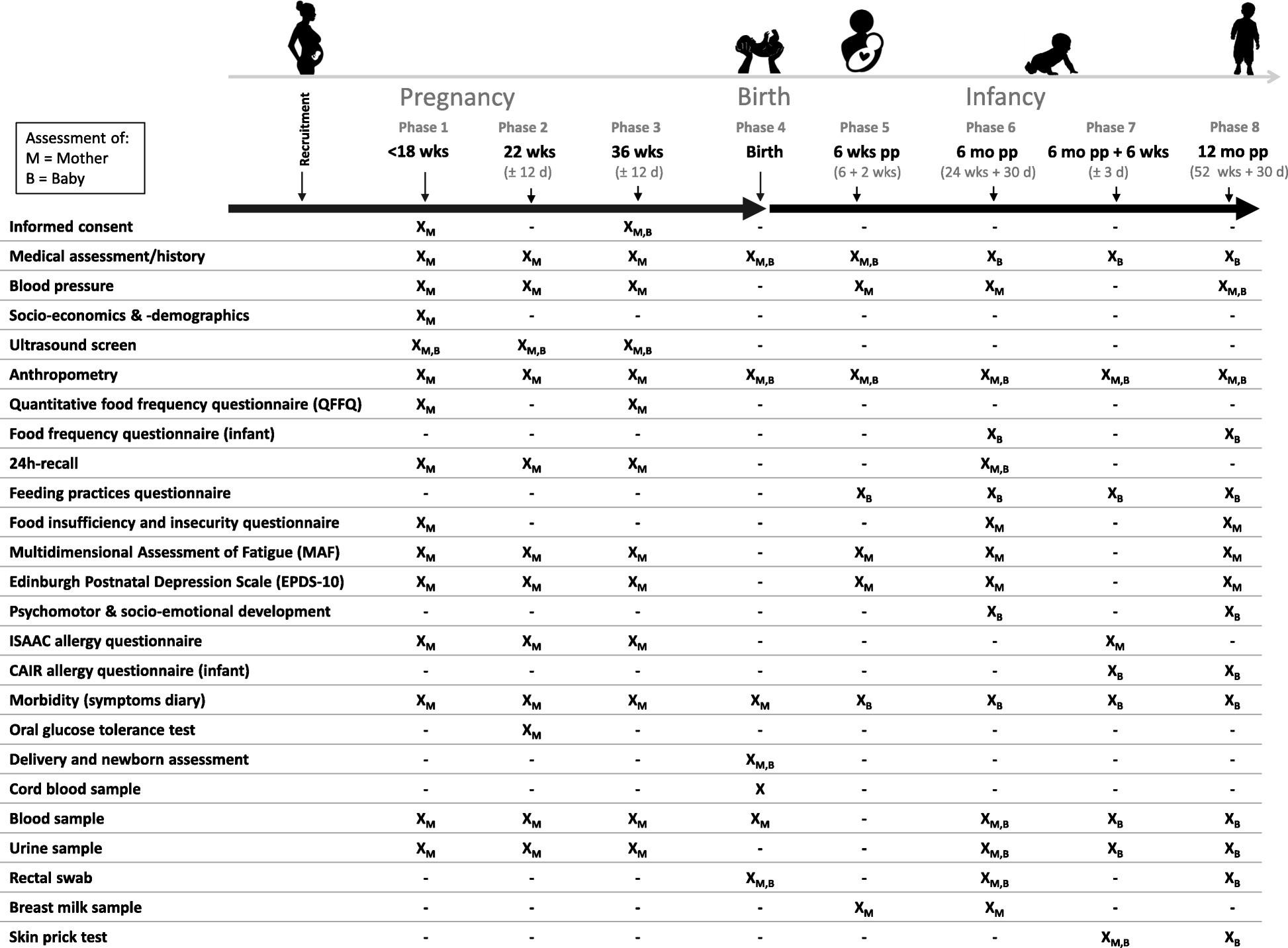 Nutrition during pregnancy and early development (NuPED) in urban ...
Nutrition during pregnancy and early development (NuPED) in urban ... Table 5 from Validity and reproducibility of a food frequency ...
Table 5 from Validity and reproducibility of a food frequency ...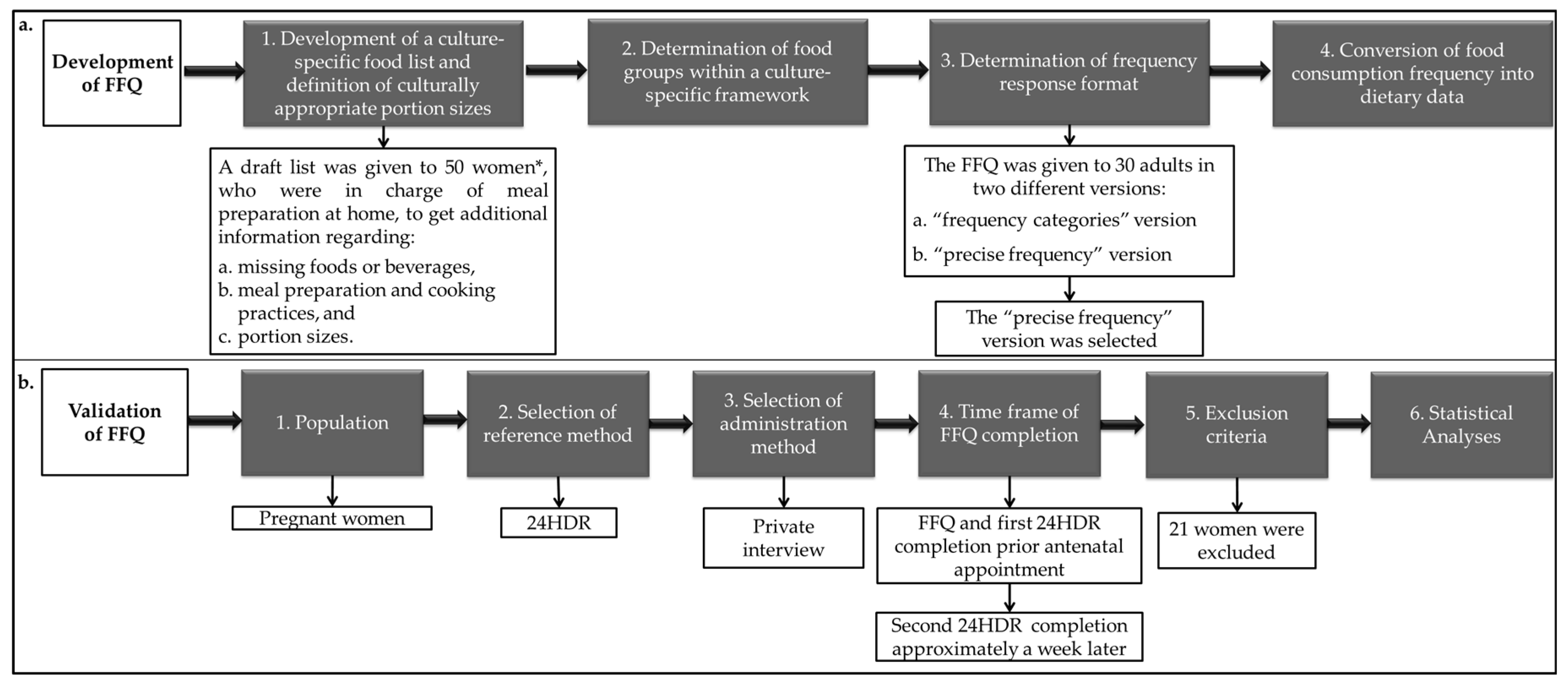 Nutrients | Free Full-Text | Development and Validation of a ...
Nutrients | Free Full-Text | Development and Validation of a ... Maternal diet and vitamin D during pregnancy and association with ...
Maternal diet and vitamin D during pregnancy and association with ... PDF) Reproducibility and validity of a food frequency ...
PDF) Reproducibility and validity of a food frequency ... Development and validation of a food frequency questionnaire for ...
Development and validation of a food frequency questionnaire for ...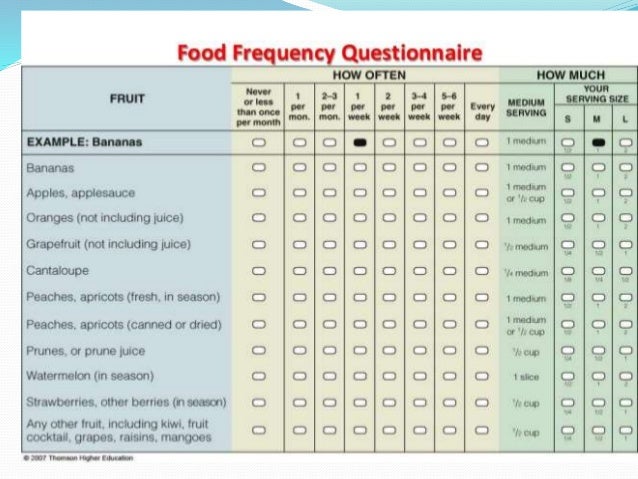 DIETARY ASSESSMENT SEMINAR
DIETARY ASSESSMENT SEMINAR Fillable Online Use of a food frequency questionnaire in American ...
Fillable Online Use of a food frequency questionnaire in American ... Solved: Ch. 13 Worksheet (10pts) Selecting A Dietary Asses ...
Solved: Ch. 13 Worksheet (10pts) Selecting A Dietary Asses ... Pregnancy diet and offspring asthma risk over a 10-year period ...
Pregnancy diet and offspring asthma risk over a 10-year period ...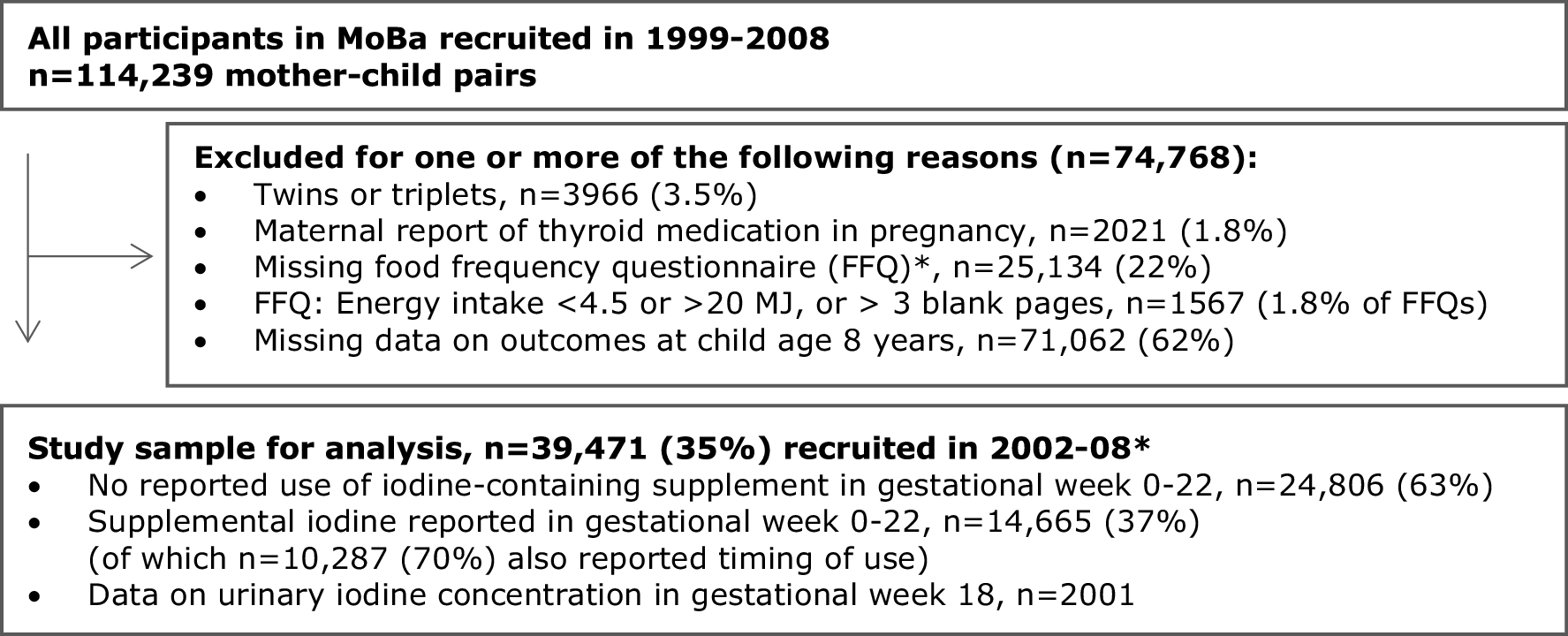 Language delay and poorer school performance in children of ...
Language delay and poorer school performance in children of ... Pin on Pregnancy Diet
Pin on Pregnancy Diet Validity of a new food frequency questionnaire for pregnant women ...
Validity of a new food frequency questionnaire for pregnant women ... Dietary intake before pregnancy (84-item food-frequency ...
Dietary intake before pregnancy (84-item food-frequency ... Development and validation of a food frequency questionnaire for ...
Development and validation of a food frequency questionnaire for ...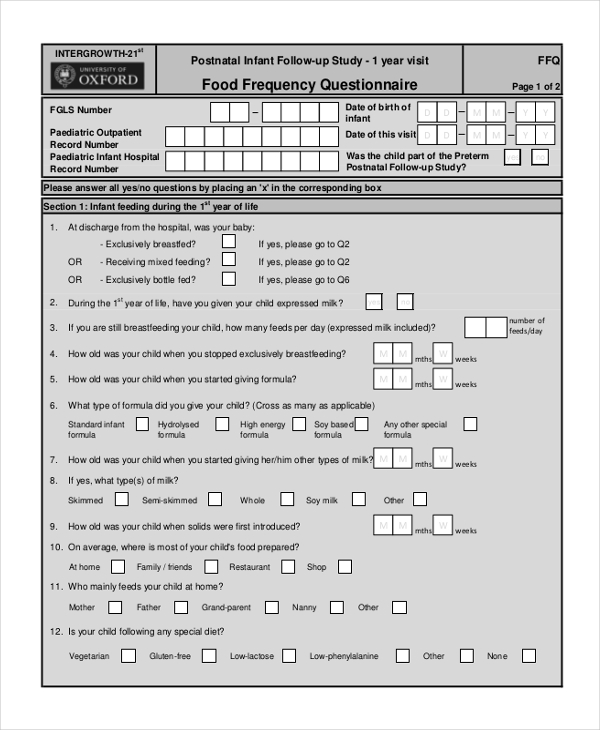 FREE 7+ Sample Food Frequency Questionnaire Forms in PDF | MS Word
FREE 7+ Sample Food Frequency Questionnaire Forms in PDF | MS Word Harvard Trauma Questionnaire - xilusfat's blog
Harvard Trauma Questionnaire - xilusfat's blog PDF) Validity and reproducibility of a semi-quantitative food ...
PDF) Validity and reproducibility of a semi-quantitative food ...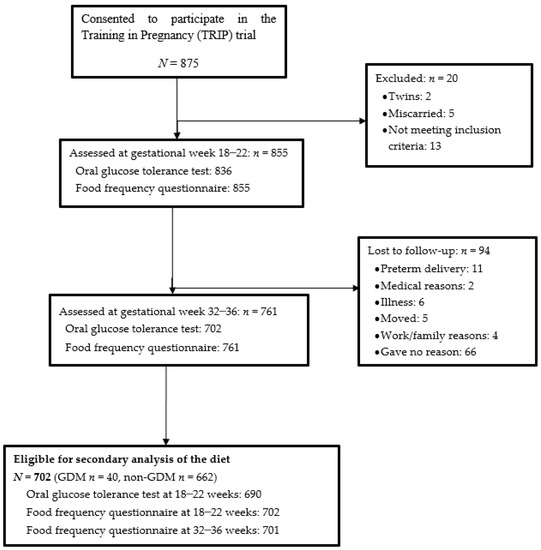 Nutrients | Free Full-Text | Dietary Intakes and Dietary Quality ...
Nutrients | Free Full-Text | Dietary Intakes and Dietary Quality ... PDF) Reliability and validity of a maternal food frequency ...
PDF) Reliability and validity of a maternal food frequency ... Validation of a food frequency questionnaire for Japanese pregnant ...
Validation of a food frequency questionnaire for Japanese pregnant ... Development and validation of a quantitative choline food ...
Development and validation of a quantitative choline food ... SciELO - Saúde Pública - High dietary calcium intake decreases ...
SciELO - Saúde Pública - High dietary calcium intake decreases ... Maternal vitamin D and E intakes during pregnancy are associated ...
Maternal vitamin D and E intakes during pregnancy are associated ...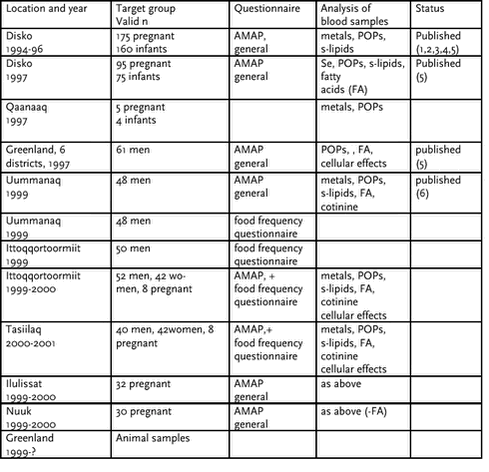 AMAP Greenland and the Faroe Islands 1997-2001
AMAP Greenland and the Faroe Islands 1997-2001 JRP - Nutritional Assessment of Childhood Cancer Survivors (the ...
JRP - Nutritional Assessment of Childhood Cancer Survivors (the ... Households' dietary habits and food consumption patterns in ...
Households' dietary habits and food consumption patterns in ... FREE 7+ Sample Food Frequency Questionnaire Forms in PDF | MS Word
FREE 7+ Sample Food Frequency Questionnaire Forms in PDF | MS Word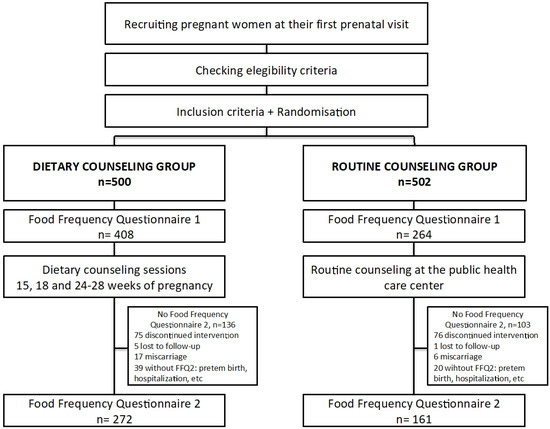 Nutrients | Free Full-Text | Effectiveness of an Intervention of ...
Nutrients | Free Full-Text | Effectiveness of an Intervention of ... Validation of a Food Frequency Questionnaire for Estimating ...
Validation of a Food Frequency Questionnaire for Estimating ... Effect of bariatric surgery before pregnancy on the vascular ...
Effect of bariatric surgery before pregnancy on the vascular ... Development and validation of a food frequency questionnaire for ...
Development and validation of a food frequency questionnaire for ... A pregnancy diet to keep mum and baby healthy - Yogurt in Nutrition
A pregnancy diet to keep mum and baby healthy - Yogurt in Nutrition JMIR - Online Dietary Intake Estimation: The Food4Me Food ...
JMIR - Online Dietary Intake Estimation: The Food4Me Food ... Japanese version of the food frequency questionnaire and its ...
Japanese version of the food frequency questionnaire and its ...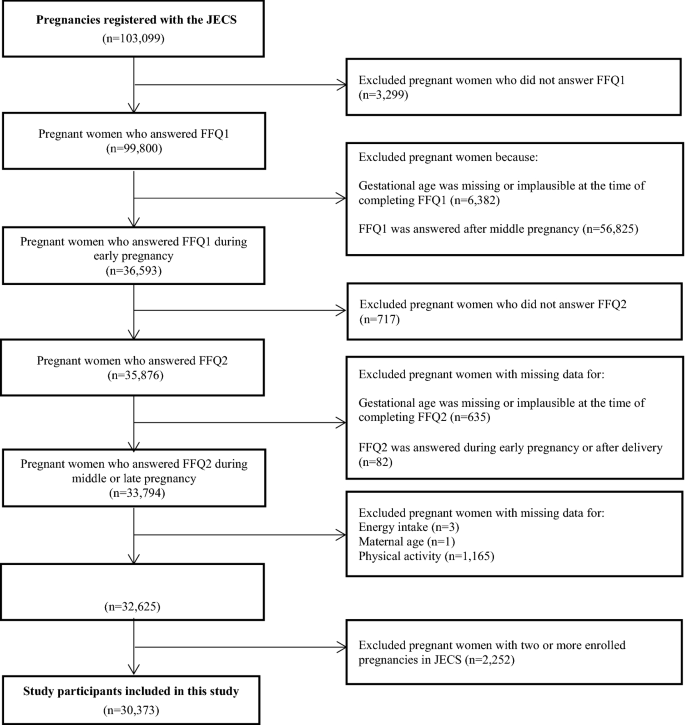 Changes in Dietary Intake in Pregnant Women from Periconception to ...
Changes in Dietary Intake in Pregnant Women from Periconception to ... Table 1 from Validity and reproducibility of a semi-quantitative ...
Table 1 from Validity and reproducibility of a semi-quantitative ... Validation of a Foodfrequency Questionnaire for Use in Pregnancy ...
Validation of a Foodfrequency Questionnaire for Use in Pregnancy ... Maternal Lipids Are as Important as Glucose for Fetal Growth ...
Maternal Lipids Are as Important as Glucose for Fetal Growth ... Fillable Online Assessment of Pre-Pregnancy Dietary Intake with a ...
Fillable Online Assessment of Pre-Pregnancy Dietary Intake with a ...
Posting Komentar
Posting Komentar